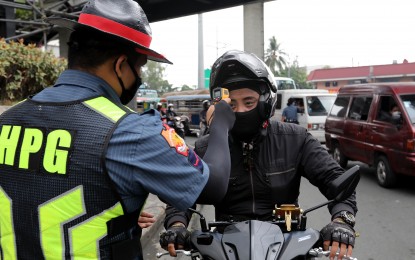
CHECKPOINT. An HPG personnel checks the temperature of a motorcycle rider at a checkpoint along the boundary of Cainta, Rizal and Marikina City during the early days of the enhanced community quarantine in March. Presidential Spokesperson Harry Roque raised the possibility that the IATF might downgrade the classification of community quarantine in places under MGCQ and general community quarantine. (File photo)
MANILA – The Inter-Agency Task Force for the Management of Emerging Infectious Diseases (IATF-EID) would assess whether areas put under modified general community quarantine (MGCQ) are ready for the transition to the “new normal,” Malacañang said on Wednesday.
Presidential Spokesperson Harry Roque raised the possibility that the IATF-EID might downgrade the classification of community quarantine in places under MGCQ and general community quarantine (GCQ).
“We now have quite a number of provinces under MGCQ and GCQ. So when we talk about revisions, we’ll see if we can have a lower classification – new normal for those under MGCQ, or MGCQ for those that are still in GCQ,” Roque said in an interview with ABS-CBN News Channel.
There can only be a new normal when areas in the country are no longer under community quarantine.
Before an area can be considered as being under the new normal, the community quarantine implemented there needs to transition first into MGCQ.
On Tuesday, Malacañang said there was a likelihood of again imposing stricter quarantine restrictions in areas where coronavirus disease 2019 (Covid-19) infections continue to rise.
Roque said the IATF-EID’s decision on quarantine classifications beginning June 16 would depend on “scientific” data.
“The most important, of course, is what will happen on June 16 and I think the entire nation is clearly awaiting the decision of the IATF. Now, I would like to stress that actually, when we decide whether or not to ease further or to retain the classification is always scientific data,” he said.
Members of the IATF-EID is scheduled to discuss on Wednesday afternoon the possible relaxation or tightening of quarantine rules in the country on June 16.
President Rodrigo Duterte will then meet with the IATF-EID in Davao City on Thursday to evaluate the task force’s recommendations.
‘Very careful’ in assessing MM, Cebu City
Roque said the IATF-EID would be “very careful” in assessing the situation in Metro Manila and Cebu City where the number of Covid-19 cases continues to increase.
“I would say that these two areas – Metro Manila and Cebu City – would take quite some time in the discussion that will take place this afternoon,” he said.
Roque said the IATF-EID would look for “indicators” that the second wave of Covid-19 infections would not emerge in case it lowers the classification of community quarantine in Metro Manila and Cebu City to MGCQ.
“We’re still looking for some kind of data that would indicate that Metro Manila (and Cebu City) if we give (them) more liberty so to speak under the MGCQ, will not spark a second wave. We cannot afford a second wave,” he said.
The classification of community quarantine starting June 16 would be based on the case doubling rate and critical health care capacity.
Roque said the IATF-EID might allow the implementation of MGCQ in Metro Manila and Cebu City if it is proven that they can attend to the needs of people infected with Covid-19.
“Even if the numbers may be going up, if we have the capacity to take care of them (Covid-19 patients) in case they get sick really in a critical manner, it could still be decided that we could graduate to a lower degree of classification,” he said.
Areas that are under GCQ until June 15 include Pangasinan, Cagayan Valley, Central Luzon, Calabarzon, Metro Manila, Central Visayas, Zamboanga City, Davao City, Albay, Cebu City, and Mandaue City.
MGCQ, the last quarantine classification before the shift to new normal, is imposed in the rest of the country. (PNA)
